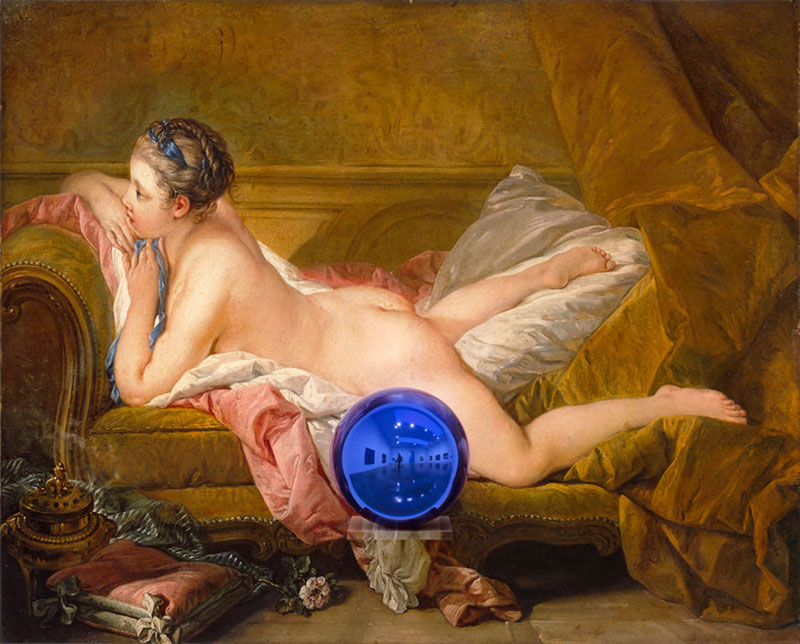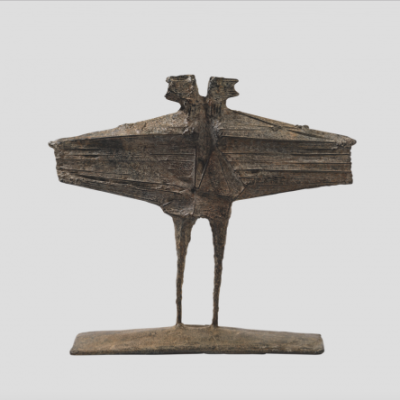Greedy Jeff Koons, bored of dominating the contemporary scene, has for years wanted to get himself the canon. So it is that, in his latest show at Almine Rech’s new Mayfair space, the viewer is greeted by Tintoretto’s masterwork The Origin of the Milky Way – or rather, Koons’s version of it. Along with the seven other historical compositions displayed in the gallery, it is a replica. The lower centre of each canvas is dominated by the contemporary artist’s addition of a glass ball in the same deep lapis lazuli that is so prominent in the Venetian’s painting.
Seated Ballerina (2010–15), Jeff Koons. © Jeff Koons – Courtesy of the artist and Almine Rech Gallery. Photo: Consultatio Real Estate

There are other works on display here, such as the seated ballerina in the centre of the room made of Koons’s trademark immaculately shining steel, and don’t get me wrong – they are striking enough. But the first thing you want to look at is your own head reflected in one of those blue globes. Koons’s original Gazing Ball sculptures debuted at New York’s David Zwirner gallery in 2013, and a series of paintings was shown at Gagosian last year. Many of these ones are new, and like the rest they are selfie-ready, positively inviting gallery-goers to point their smartphones at them. This is crafty. It becomes impossible to get lost in the work: instead, you are constantly reminded of yourself, standing in Koons’s commodified vision of art, an ever-present consumer. Opening as it did during Frieze week, the show could even be seen as a send up of art fairs in general. Lose the glass and aluminium and you have the ultimate Frieze Masters stall.
Gazing Ball (Boucher Reclining Girl) (2014–15), Jeff Koons. © Jeff Koons – Courtesy of the artist and Almine Rech Gallery

Even a true Koons sceptic will find some subtlety here. Art history’s hall of fame becomes a hall of mirrors: wherever you can see a Giotto, a Titian or a Tintoretto, there’s a Koons sculpture alongside it and reflected within it. In Koons’s opinion, he belongs with the greats. (Or ahead of them: each canvas is simply entitled Gazing Ball, with the names of the originals and their creators tagging along in parentheses.) In some cases, Koons fits in well aesthetically. His own ballerina can be seen reflected in the ball attached to François Boucher’s Reclining Girl: her shiny, sweet-wrapper dress echoes the equally sugary silks depicted by the 18th-century French painter. And on the packed opening night, Koons effortlessly produced his own crowd scenes in the narrow walkway between the battles and revels of Jacques-Louis David’s The Intervention of the Sabine Woman and Poussin’s 1636 The Triumph of Pan.
Gazing Ball (Giotto the Kiss of Judas) (2016), Jeff Koons. © Jeff Koons – Courtesy of the artist and Almine Rech Gallery

The paintings, executed by Koons and his army of studio assistants, record every last detail down to patina and craquelure, but they are all a bit too regular. The surface of Goltzius’s Hercules and Cacus appears as flat as the Giotto, and it takes a proper look to confirm that the copies are painted rather than screen-printed. Had Koons instructed his technicians to produce top quality fakes, like the Frans Hals that recently fooled Sotheby’s, this could have been a really great exhibition, playing deeply with the idea of mastering the masters.
Nevertheless, these works are more engaging than the artist’s hoovers and inflatables that are currently to be found in Damien Hirst’s Newport Street Gallery (until 16 October). Koons’s Gazing Ball series, unlike much of his work, appeals immediately to the brain as well as the eye. Whether his art belongs on equal footing with the Old Masters is up for debate, but at least he’s making his case in more interesting ways.
‘Jeff Koons’ is at Almine Rech Gallery, London, until 21 January 2017.
Gazing Ball (Titian Pastoral Concert) (detail; 2016), Jeff Koons. © Jeff Koons – Courtesy of the artist and Almine Rech Gallery




